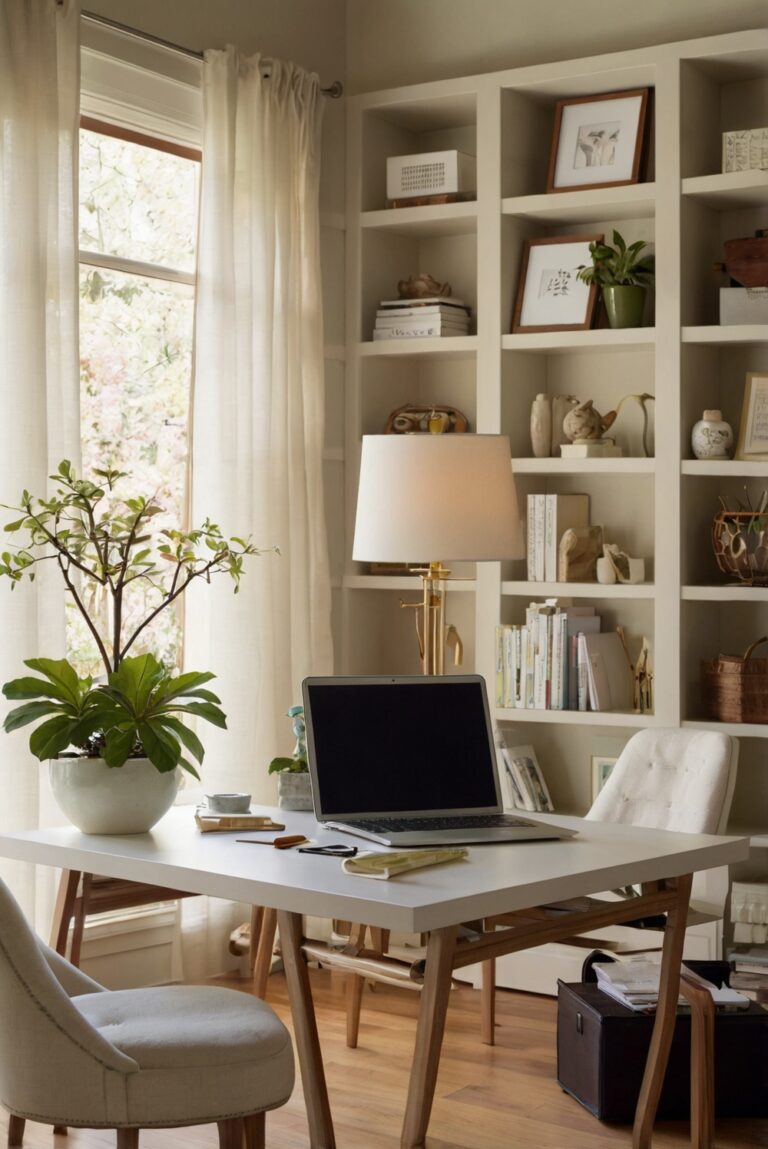How to create a cleaning schedule for a home office?

Learn how to efficiently organize and maintain your home office with a practical cleaning schedule tailored for busy interior designers.
To create a cleaning schedule for a home office as part of your daily routine with your home decorating ideas, start by designating specific days for certain tasks. For example, Mondays can be for dusting and organizing your desk, while Wednesdays can be for vacuuming and wiping down surfaces. Incorporate your home decor interior design by adding decorative storage solutions to keep the office clutter-free. Space planning is essential to make your home office functional and visually appealing. Consider painting the walls with primer paint and color-match your furniture to create a cohesive look. By following a consistent routine and integrating your interior design preferences, you can maintain a clean and inspiring home office environment.
Identify the cleaning tasks:
When creating a cleaning schedule for your home office, the first step is to identify all the cleaning tasks that need to be done. This includes dusting, vacuuming, wiping down surfaces, organizing paperwork, cleaning electronics, and any other tasks specific to your workspace.
Determine the frequency:
Once you have identified the cleaning tasks, you need to determine how often each task needs to be done. Some tasks, like emptying the trash or wiping down surfaces, may need to be done daily, while others, like deep cleaning the office equipment, can be done on a weekly or monthly basis.
Create a cleaning schedule:
With the tasks and their frequencies in mind, create a cleaning schedule that outlines when each task will be completed. You can create a weekly or monthly schedule, depending on your needs and the size of your home office. Be sure to allocate enough time for each task and make sure to stick to the schedule.
Consider your workflow:
When creating a cleaning schedule for your home office, consider your workflow and daily routine. For example, if you tend to have more meetings on certain days, schedule lighter cleaning tasks for those days. This will help ensure that your cleaning schedule is realistic and achievable.
Delegate tasks:
If you share your home office space with others, consider delegating cleaning tasks to different members of the household. This can help distribute the workload and ensure that the cleaning tasks are done consistently and efficiently.
In conclusion, creating a cleaning schedule for your home office is essential to maintain a clean and organized workspace. By following these steps and considering your workflow and delegating tasks where necessary, you can create a schedule that works for you and helps you stay on top of your cleaning responsibilities.
1. What are the key steps to creating a cleaning schedule for a home office?
Creating a cleaning schedule for a home office involves several key steps. First, assess the cleaning needs of your home office by identifying high-traffic areas and areas prone to dust or clutter. Next, determine how often each task needs to be done, such as daily, weekly, or monthly. Then, allocate specific tasks to certain days or times to create a consistent cleaning routine. Finally, adjust the schedule as needed based on your workload or changes in cleaning priorities.
2. How can I prioritize tasks when creating a cleaning schedule for a home office?
When creating a cleaning schedule for a home office, it’s important to prioritize tasks based on their importance and frequency. Start by identifying essential tasks that need to be done daily, such as emptying the trash or wiping down surfaces. Then, move on to weekly tasks like vacuuming or dusting. Finally, schedule monthly tasks such as cleaning windows or organizing files. By prioritizing tasks in this way, you can ensure that your home office stays clean and organized without feeling overwhelmed by the workload.
3. What are some useful tips for maintaining a cleaning schedule for a home office?
To maintain a cleaning schedule for a home office, consider incorporating some helpful tips. First, break down larger tasks into smaller, more manageable chunks to make them easier to tackle. Additionally, set aside dedicated time each day or week for cleaning to ensure that it becomes a regular part of your routine. Consider using storage solutions like bins or shelves to keep clutter at bay and make cleaning easier. Finally, enlist the help of family members or colleagues to share the cleaning responsibilities and keep the space tidy.
4. How can I stay motivated to follow a cleaning schedule for a home office?
Staying motivated to follow a cleaning schedule for a home office can be challenging, but there are several strategies you can use to stay on track. Set specific, achievable cleaning goals for yourself, such as decluttering a certain area or completing a particular task. Reward yourself for meeting these goals, whether it’s with a break, a treat, or some other form of positive reinforcement. Keep track of your progress by marking tasks off a checklist or using a cleaning app to stay organized. Finally, remind yourself of the benefits of a clean and organized workspace, such as increased productivity and reduced stress, to stay motivated.
5. How can I adapt my cleaning schedule for a home office to fit my busy lifestyle?
Adapting a cleaning schedule for a home office to fit a busy lifestyle requires some flexibility and creativity. Consider streamlining your cleaning routine by focusing on high-impact tasks that make a big difference in the appearance and functionality of your workspace. Delegate tasks to family members or colleagues to lighten your workload and free up time for other priorities. Incorporate quick cleaning hacks like using multipurpose cleaning products or setting a timer to stay on task. Finally, be willing to adjust your schedule as needed to accommodate changes in your workload or personal commitments.






